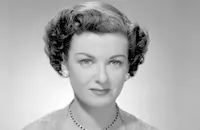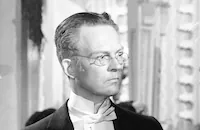She Wanted a Millionaire
Brief Synopsis
Cast & Crew
John Blystone
Joan Bennett
Spencer Tracy
Una Merkel
James Kirkwood
Dorothy Peterson
Film Details
Technical Specs

Synopsis
Jane Miller, the daughter of a railroad brakeman, leaves her wealthy date when he attempts to kiss her and then take her to his home. As she walks home, William Kelley, the assistant foreman of the railroad, offers her a ride home on his train, and then at her home, intercedes when her father threatens to hit her with a strap. After Jane's father is killed in a railroad accident, Jane tells Bill that she must now marry a rich man, if she can, and Bill, who loves her, vows that he will be rich someday. Bill sends in Jane's picture as a beauty contest entry, and she becomes Miss Missouri. She travels to Atlantic City for the Miss Universe contest, where millionaire Roger Norton, one of the judges, takes an interest in her. After Jane wins, due to Roger's influence, she breaks a date with Bill, who planned that night to propose, to be with Roger. At 2:30 that morning, Bill finds them embracing, but when he learns that she has accepted Roger's marriage proposal, he wishes them both good luck before going to get drunk with Jane's friend, newspaperwoman Mary Taylor. Roger quickly shows his intense jealousy and a violent streak when, on their honeymoon, he hits a bellboy for helping Jane take off her coat. That night, he forcibly enters their bedroom despite Jane's request that he wait. Although she is happy that Roger's money takes care of her mother and sisters, Jane is further troubled when Roger tells of his three previous marriages to a chorus girl, schoolteacher and artists' model, the latter of whom committed suicide. After a trip to Paris, where Roger remakes Jane's appearance to suit him, they move into his estate. During the next year, he becomes increasingly suspicious of her instructors. Jane decides to leave Roger, but when he reminds her about the payments to her family, she resigns herself to remain with him. Bill, now the assistant to the president of the railroad, runs into Mary in Europe and goes with her to a costume ball, which Mary says Jane will attend. Roger witnesses Jane's excitement at seeing Bill and returns to the estate, where he gets drunk. Bill comforts Jane when she starts crying about her marriage and confesses that he still loves her. They return to the estate and confront Roger with Jane's decision to divorce him and marry Bill. Roger concedes graciously, but after Bill leaves, Roger enters Jane's room through a secret passageway and threatens to feed her to his great dane Baskerville. Jane faints, but Roger is prevented from carrying out his threat when his servant Monk, whom he earlier insulted, appears at the kennel with a pistol. Back in Jane's room, when Roger attempts to strangle her, she grabs his pistol from his pocket, but before she can shoot, Monk appears in the secret doorway and shoots Roger to death. Jane gives Roger's money to charity. When Bill tells her she will be going home soon, Jane, dazed, does not respond.

Director
John Blystone
Cast

Joan Bennett

Spencer Tracy

Una Merkel

James Kirkwood

Dorothy Peterson
Douglas Cosgrove

Donald Dillaway
Tetsu Komai
Constantine Romanoff
Anita Barnes
Edna Callahan
Nancy Cornelius
Sue Clark
Dorothy House
Peaches Jackson
Alice Jans
Sheila Mannors
Gwen Zetter
Beatrice Powers
Vivian Reid

June Vlasek
Elda Vokel
Rosalie Roy
Crew
Arthur Arling
Jasper Blystone
William Collier Sr.
Ralph Dixon
Frank Dolan
Sally Frank
Alexander Kahle
Sonya Levien
Louis Loeffler
Bud Mautino
William Anthony Mcguire
Luis Molina
Dudley Nichols
Albert Protzman
John Seitz
Victor M. Shapiro
Winfield R. Sheehan
Hugh Stange
Imogene Stanley
Dolly Tree
E. Clayton Ward
Gordon Wiles
Sam Wurtzel

Film Details
Technical Specs

Quotes
Trivia
Notes
Variety noted that "sometimes the tale seems to closely follow the Nixon-Nirdlinger tragedy, with all the elemental points present." Included in the files for the film in the Twentieth Century-Fox Produced Scripts Collection at the UCLA Theater Arts Library is a Los Angeles Evening Herald newspaper article, dated March 13, 1931, which describes the above-mentioned events. According to the article, Charlotte Isabel Nash, as "Miss St. Louis," won the beauty prize in the Atlantic City beauty contest of 1923, at which Frederick G. Nixon-Nirdlinger, a wealthy theater owner and "connoisseur of women," was a judge. Nirdlinger, twenty-nine years older than Charlotte and married twice before, sent her to a fashionable finishing school and paid for special tutors for her. He vowed, "I will make her more desired than Cleopatra. I will make her mind as gorgeous as her body. I will do with a living woman what painters and sculptors seek to do with paint and clay." In 1924, they married, and he eventually deemed her "perfect." On March 11, 1931, Mrs. Nixon-Nirdlinger shot and killed her husband in their Nice home. Through an attorney, she stated: "My husband was continually accusing me of infidelity....If a man even so much as glanced at me, he immediately accused me of being the man's mistress. We often went to the casino and night clubs, but my husband invariably imagined that some man was endeavoring to flirt with me." The night of the shooting, according to her, Nirdlinger noticed she was reading an Italian newspaper and accused her of having an Italian lover. After drinking some whiskey, he suddenly tried to strangle her, whereupon she shot him. According to other newspaper articles about the trial, the jury took only nine minutes to find Mrs. Nixon-Nirdlinger not guilty of murder or even manslaughter. The first story outline in the Fox files is dated March 27, 1931, only sixteen days after the shooting.
According to news items and the Twentieth Century-Fox Records of the Legal Department at the UCLA Theater Arts Library, production stopped on July 28, 1931 on account of an injury Joan Bennett sustained during a fall from a horse and shooting was delayed several months. The legal files also state that Dorothy Peterson was borrowed from First National and that a role played by Lucille La Verne was eliminated from the final film. According to publicity material for the film, some scenes were shot at the Goodyear plant in Los Angeles and at various locations in and around Hollywood, in addition to Redondo Beach, where a reproduction of the Atlantic City boardwalk was built. 297 film tests were conducted for the boardwalk parade and Coronation Ball and 44 "beauties" were chosen, according to the publicity. Modern sources credit John W. Considine, Jr. as producer and George Lipschultz as musical director.












